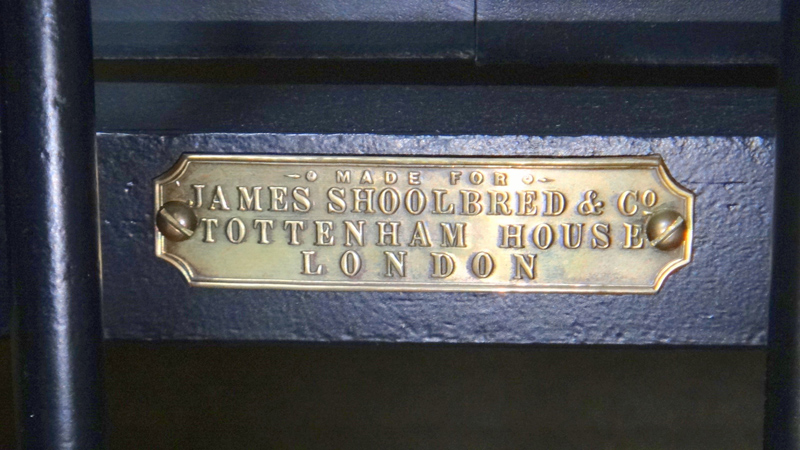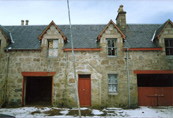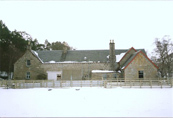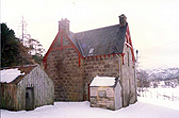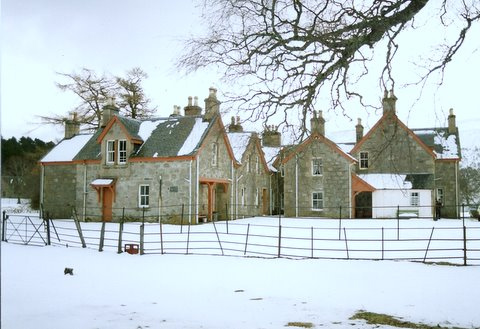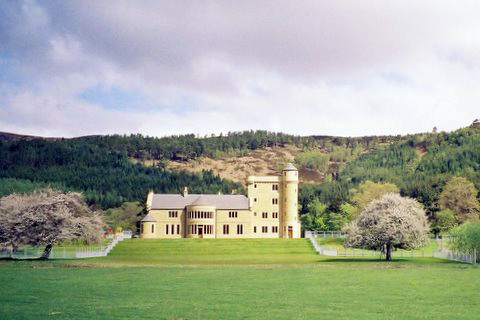History of Kildermorie
Click on these links to go to other pages
Show menuOld estates abound with myths and legends, but finding primary sources to underpin them is not straightforward. What is documented, for example in the proceedings of scientific and antiquarian societies and in statistical accounts of Scotland is fairly consistent, although the spelling of the land now known as 'Kildermorie' is not.
Until the end of the 18th Century the prevailing language was the Gaelic. Kildermorie is documented as Cille Mhuire, Cille Mhoire and Cille Moire, all derivatives of the name of the Roman Catholic chapel which was dedicated to the Virgin Mary, and which gives the glen its name. Within the last two centuries it appears in legal and other documents as Gildermorry, Gildermorrie and Gildermorie.
The ruins of the granite chapel still stand at the western end of Loch Morie, surrounded by a burial ground. The age of the chapel is not known, nor how long it has been in decay. A 1989 geological study showed the date of the stone to be 1510, and historians are certain that it was built before the Reformation.
Between the chapel and the loch is a well, Tobar Mhoire or Tobair na Muire, Mary's Well, whose water flows into Loch Morie; sadly the well is obscured by decades of scree sliding from the hill above. A market, Feill Mhoire was held regularly – one account cites twice weekly – to serve the local area, supporting the theory that a thriving community once inhabited the glen, and there is evidence of other buildings on the estate, including the remains of an ice house near the river.
The Highland Clearances
The Highland Clearances, effective from around 1750 to 1860, is the name given to the systematic removal of tenants and crofters from their land and homes, so that the landowners could lease their land to sheep farmers from the Scottish lowlands and England. The displaced crofters were either forced out of the area, or left to graze their cattle on less suitable higher ground.
For several centuries, the fate of Kildermorie was linked to the neighbouring estates of Novar (the Munro family), Ardross and Wyvis, as numerous dispositions of land between the owners testify.
In 1792, Kildermorie, then under the ownership of Sir Hector Munro of Novar, is credited with being the seat of what is known as the Ross-shire Insurrection; in a defiant gesture, a contingent of displaced crofters drove over 6,000 sheep from Easter Ross towards Beauly, near Inverness, their defiance subsequently resulting in either banishment from Scotland or deportation.
The Shoolbred family
In 1885 the neighbouring deer forest of Ben Wyvis was purchased by 'Mr Walter Shoolbred of Tottenham Court Road', who was to play an important role at Kildermorie. James Shoolbred and Company began business in the 1820s in Tottenham Court Road as drapers and built up the company to become one of London's first department stores. Shoolbred's trade extended into other lines, but it was not until about 1870 that they branched out into the furniture trade as cabinet manufacturers.
Shoolbreds were among the royal appointees in the mid-1880s, which perhaps explains why Walter Shoolbred was targeted by 'Mr Punch'
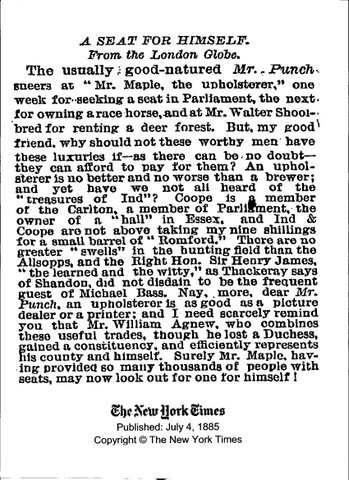
In 1890 Walter Shoolbred purchased the adjoining land of Kildermorie from R. C. Munro Ferguson of Novar. The main house was furnished by his own company, and many items similar to those shown in the company's catalogue of 1876 are in use in the estate buildings today.
Kildermorie stayed in the Shoolbred family until 1912 when it was sold, except for a small parcel of land which was retained by Rupert Shoolbred. (See later)
Sauce and Poetry
The industrialist and philanthropist Charles William Dyson Perrins, of Worcestershire Sauce fame, owned the neighbouring Ardross Estate and added Kildermorie to his substantial property portfolio in 1912.
In 1920 Perrins employed Christopher Murray Grieve, a journalist in need of a change of occupation. Though employed as Perrins’ caretaker and as schoolteacher to the head stalker’s children, Grieve regularly wrote letters and poems inspired by Kildermorie’s beauty and remoteness. Subsequently, after returning to journalism, he adopted the pseudonym Hugh MacDiarmid, and the literature created during his tenure at Kildermorie can be found under that name.
Dyson Perrins was extremely generous to the local community, building a local men's club which included a library, a reading room and billiard room, and gifting the Alness golf course to the town.
Division and Restitution
In 1924 Kildermorie was sold to The Ardross Estates Company, and in 1937 to William Shearer.
In 1942 a Disposition by Lieut. Col. Rupert Shoolbred states :-
"... [I] DO HEREBY DISPONE to and in favour of the said William Shearer and his heirs and assignees whomsoever heritably and irredeemably ALL and WHOLE that small piece of land containing inter alia an old ruined building situated near the Lodge at Kildermorie and surrounded by a stone wall in which piece of ground repose the ashes of Walter Shoolbred formerly proprietor of the Estate of Kildermorie ..."
The base of the cross bears the inscription 'Walter Shoolbred of Wyvis born June 20 1842 died Nov 18 1904'. So, after thirty years, ownership of Cille Mhuire, the burial ground was returned to Kildermorie.
Following Mr Shearer's death, the Secretary of State for Scotland acquired the land in 1954 from his Trustees to settle Death Duties. In 1956 the bulk of the land passed into private ownership again, though some was retained by the Secretary of State for Scotland for forestry, and remained more or less intact until 1990. Then the incumbent family divided the estate into Kildermorie North and Kildermorie South and sold the southern half, with a minute of agreement essentially allowing the estate to continue to be managed as a whole. That arrangement lasted for only 3 years when the northern part also was offered for sale.
The present owners purchased both parts of Kildermorie simultaneously in 1994, and have systematically purchased small parcels of embedded land from the Forestry Commission in order to create a more secluded estate.
The Challenge
By 1994 all buildings were either in a poor state of repair or long derelict, and the river, paths, fences and pastures had fared no better.
The exact age of the original Kildermorie Lodge (below left) is unclear, but the Inverness Advertiser of Tuesday 22 December 1863 ran an advertisement placed by Novar Estate which read "Tenders wanted for extensions to Gildermorie Shooting Lodge". Although presenting its best side for the 1993 sale particulars, it had become by additions over the years a charmless, crumbling rabbit-warren and had serious structural defects.
It was demolished in 1994 and a new house (above right), set in its own grounds was built as a private residence for the estate owners.
The surrounding estate buildings were deemed salvageable and by various processes of restoration, renovation, extension and relocation have been given new purpose. Materials from the old lodge were painstakingly removed and reused in other buildings; granite blocks, sandstone quoins and lintels, Ballachulish roof slates, light fittings, original Shoolbred furniture , doors – even a staircase – brought their historical associations with them.
Running parallel with the building works was the creation of the supporting infrastructure. This included the construction of a hydro-electric scheme with a back-up generator, the harnessing of spring water and provision for sewage treatment.
The strengthening of river banks, restoration of existing salmon pools, reinstatement of pony paths, removal of derelict post and wire fencing whose purpose was long forgotten can now be seen as the 'tip of the iceberg' in the whole process of rebuilding Kildermorie as a traditional sporting estate. Some of the land was found to be inaccessible to stalkers, so an ancient access road was repaired, land was drained and flight ponds developed.
Paradoxically, the estate was being double-grazed; in addition to the wild deer, a flock of blackface sheep was roaming free. At the first opportunity the sheep were taken to market. So, two centuries after the Ross-shire Insurrection, Kildermorie was finally free of sheep, leaving the hills and valleys in their natural wild state.
In recent years the electricity supply has been upgraded by the incorporation of battery storage, a borehole water supply has been commissioned, a communications centre powered by solar and wind energy was erected to supply superfast broadband directly to all guest accommodation, charging points for electric vehicles have been installed – all to suit 21st Century life whilst retaining the essence of the original sporting estate.
